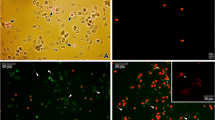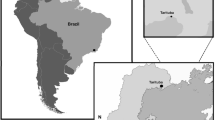Abstract.
Samples of two species of shellfish that form part of the human food chain (the oyster Ostrea edulis and the marine clam Tapes decussatus) were experimentally contaminated with Cryptosporidium parvum oocysts. Changes in the viability of oocysts subsequently recovered from the shellfish were evaluated by means of an immunofluorescent antibody technique (IFAT) and inclusion/exclusion of the fluorogenic vital dye propidium iodide. There was a sharp decrease in oocyst viability during the first 4 days, with 15–25% viable oocysts remaining thereafter. In addition the infectivity of these oocysts at 10 and 31 days post-contamination was demonstrated using a suckling murine model.
Similar content being viewed by others
Author information
Authors and Affiliations
Additional information
Electronic Publication
Rights and permissions
About this article
Cite this article
Freire-Santos, F., Gómez-Couso, H., Ortega-Iñarrea, M. et al. Survival of Cryptosporidium parvum oocysts recovered from experimentally contaminated oysters (Ostrea edulis) and clams (Tapes decussatus). Parasitol Res 88, 130–133 (2002). https://doi.org/10.1007/s004360100470
Received:
Accepted:
Published:
Issue Date:
DOI: https://doi.org/10.1007/s004360100470




